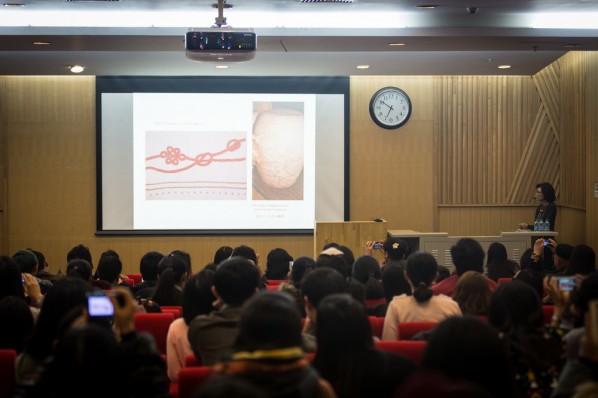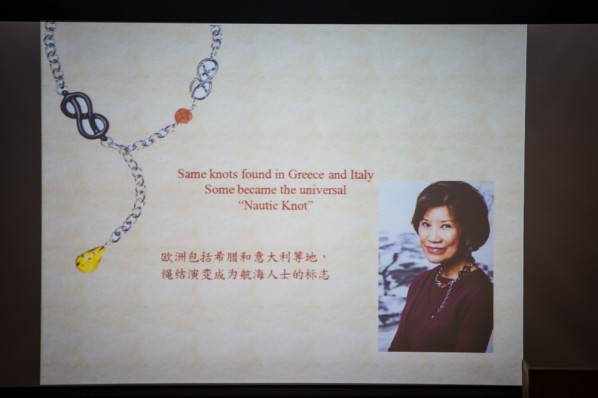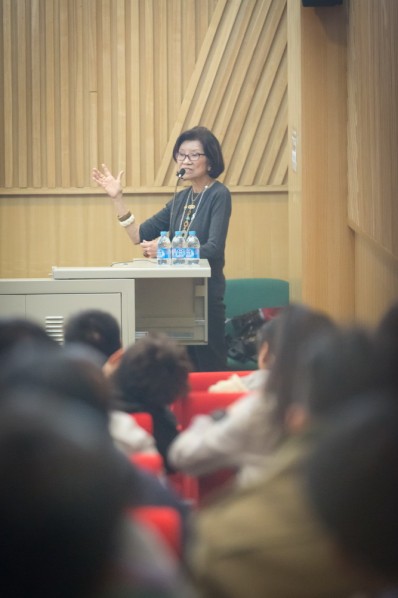
At 18:00 on November 13, 2013, the international famous brand, diversified designer Kai-Yin Lo launched a lecture entitled “The Eternal Design Without a Boarder” at the red chair lecture hall in building 7, CAFA. The lecture was organized by the School of Design, CAFA, and presided over by Wang Min, Dean of the School of Design, who gave an introduction to Ms. Kai-Yin Lo at the beginning of the lecture.
Wang Min said Ms. Lo was not only an international well-known jewelry designer, but also an expert, researcher and organizer of cultural activities and exhibitions. She had won the “World’s Outstanding Chinese Designer Award” from the Hong Kong Design Center in 2007, and praised and called a “Renaissance person” (also known as a “polymath”) by the Wall Street Journal. She is currently a member of the Hong Kong Design Center committee, West Kowloon Cultural District Authority Museum Committee, British Tate Modern Asia-Pacific Collection Committee, New York Museum of Arts and Design International Committee, New York State Association International Committee and Hong Kong Art Committee, a Chief Lecturer of Central Saint Martins College of Arts and Design, London, a visiting professor at CAFA.

Kai-Yin Lo initially explained the title of the lecture – “The Eternal Design Without a Border” in the lecture. She said, under the background of global integration, the communication between China and the West has become more and more frequent, increasingly closely linked, and these exchanges and contacts are “without a border”, as the mutually influenced and blended rarely appear in the design world.
Subsequently, Kai-Yin Lo talked about her views on the creative design. She believed that originality was to pursue, question, explore, and integrate the history, culture, art, while the most important thing was applying originality in the real practice. Lo said she was a student of European history in the University of Cambridge and University of London. She had never studied design, but as a designer she had an opportunity to have a further understanding of the historical culture and heritage. She stressed that art and design was a way to express our understanding of the surrounding world, the process of design could not only give it form, but also improve the value.
Kai-Yin Lo’s design is often a new deduction for the old thing. She believes that the past, present and future, traditional and contemporary, the East and West are actually a whole, and the only way to make it a new, cross-border, eternal, valuable whole, which is actually the design idea running through the works of Kai-Yin Lo.

Kai-Yin Lo said she was very fond of a Japanese designer Issey Miyake, whose fashion design was the subversion of the traditional Japanese views on clothing. After that, Lo showcased her works of design on the large screen. She said, although the value of handicrafts was lower than art in the traditional view, her design focused on some handicrafts, ornaments, and is committed to promote crafts to art.
In 1991, Suzy Menkes, a fashion editor at International Herald Tribune had an evaluation of Kai-Yin Lo as the “Pioneer to create a new actual path for jewelry, to put color stones into the mainstream of jewelry design, to create a new concept of the value of jewelry.” Lo considered it as the most precious evaluation for her.
Lo said, in addition to the use of color jewelry, reference of ancient accessories, it was very important to have a new interpretation and use of the “knots” factor.
In the designs by Kai-Yin Lo, we have always been able to understand the character that was the mutual blending and influence of the ancient and present, the East and West. As David Pilling, editor of Asia-Financial Times said, she “makes history that is wearable”, she “makes use of contemporary feeling to interpret cultural tradition”. Lo constantly interprets a new feature from old things, mixing the historical and modern elements, while her unique designs showcase a new thinking in jewelry design from a Chinese designer. In a manner of speaking, she is a model of Chinese designers both in academic and design circles.
Journalist: Chen Yifei, Photograph: Hu Zhiheng/CAFA ART INFO
Translated by Chen Peihua and edited by Sue/CAFA ART INFO




























